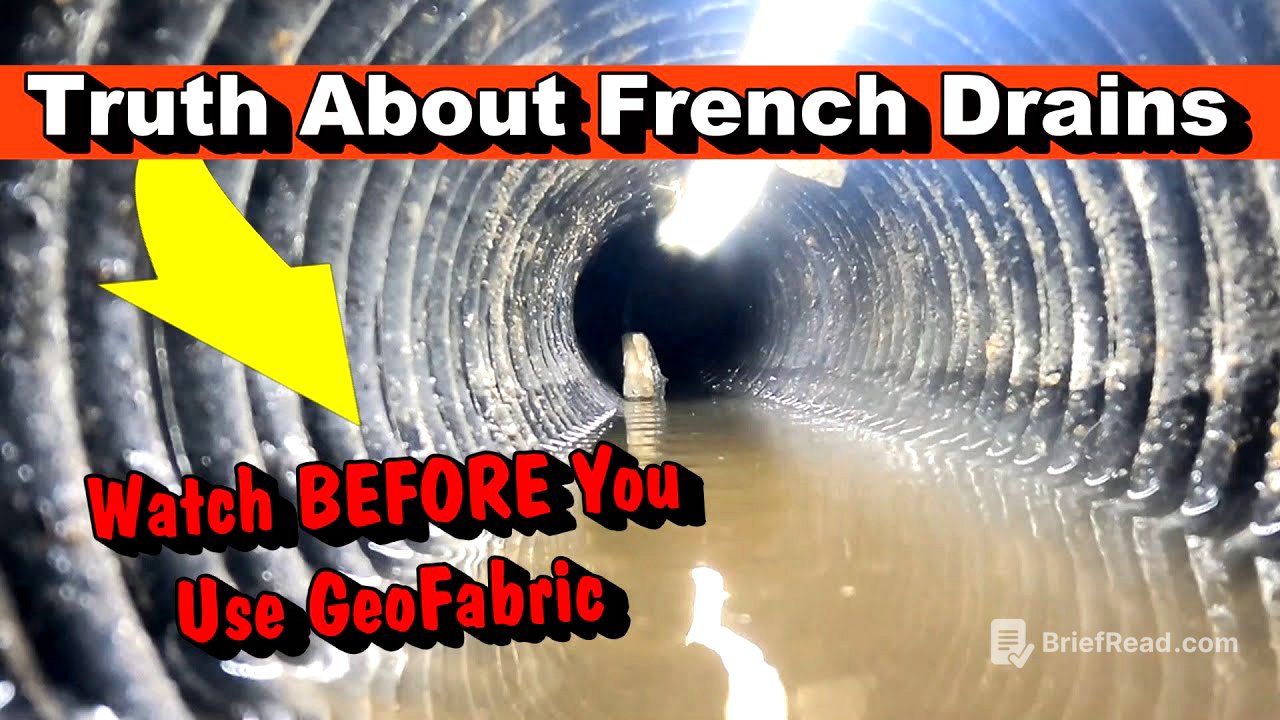TLDR;
This video is a compilation of two videos about the truth about fabric for French drains. It discusses the effectiveness of different types of fabrics, including 4oz, 8oz geotextile, and landscaping fabric, in various soil conditions like clay and sand. The video also covers the proper installation techniques for French drains using both corrugated and PVC pipes, emphasizing the importance of gravel and addressing common misconceptions about pipe types and fittings.
- Fabrics may not significantly improve drainage in clay soils.
- The type of pipe (slotted vs. holes) and its orientation matter for water inflow.
- Gravel base is crucial for French drain functionality.
The Truth About Geofabric [0:34]
The video addresses the hype around geofabric in French drains, presenting facts about its effectiveness. It begins by testing 4oz fabric, commonly used in NDS quick drains, with clay soil. The test shows that while water does pass through, the drainage is slow, and water tends to sit on top of the fabric. The presenter emphasizes that a French drain works because water rises and enters the gravel and perforated pipe system, regardless of fabric use. In sandy soils, fabric is more beneficial to prevent sand from entering the system. The presenter shares that his drains installed over 30 years without fabric still function effectively.
Different Types of Fabric and Pipes [5:24]
The video compares different types of fabrics, including 8oz geotextile fabric and standard landscaping fabric, testing their effectiveness with clay. The results indicate that landscaping fabric performs similarly to the more expensive 4oz fabric in allowing water to pass through clay. The presenter highlights the importance of protecting the pipe, which is why manufacturers offer fabric-wrapped pipes. He suggests using fabric across the top of gravel in northern climates to prevent sediment from dropping through. The video also touches on the history of French drains, noting their original use in septic systems where water discharges through gravel.
PVC vs Thin Walled Pipes [11:36]
The video addresses the use of PVC pipes and fittings in French drains, correcting misinformation about using Schedule 40 PVC exclusively. It demonstrates the difference between Schedule 40 and thin-walled PVC, showing that many installers use thin-walled pipes despite claiming otherwise. The presenter also critiques the idea of using PVC tape on French drains due to the presence of holes in the pipe. He then shares a technique for securely joining corrugated pipes by cutting and slicing a piece of pipe to create a tight, cost-effective coupling.
Sediment Buildup and French Drain Installation [15:25]
The video examines sediment buildup in fabric-covered drains, noting that fine sediment is the primary cause of clogging in stone systems. It reiterates that while fabric can help protect the stone, maintenance is still necessary. The presenter emphasizes that the method of digging the trench (mini excavator, trencher, or shovel) does not affect the drain's functionality. He promotes the availability of live help and video consultations for those needing assistance with drain installations.
French Drain Installation with Corrugated Pipe and Stay Green Fabric [17:45]
The video demonstrates the installation of a French drain using corrugated pipe and Stay Green fabric. The process includes digging a trench, laying the fabric, adding a base of stone, placing the perforated and slotted corrugated pipe, covering it with more stone, folding the fabric over the top, pinning it, and adding sod. The presenter highlights that water rises in the trench during rainfall, enters through the bottom of the pipe due to the gravel base, and is carried away. He recommends Stay Green fabric, available at most hardware stores, as an effective and affordable option, contrasting it with more expensive fabrics that he believes slow down water inflow.
French Drain Installation with PVC Pipe [20:57]
The video demonstrates the installation of a French drain using PVC pipe. The process involves digging the trench, laying the fabric, adding a gravel base, placing the perforated PVC pipe with holes pointing down, covering it with gravel, folding the fabric over, pinning it, and adding sod. The importance of the gravel base is emphasized, as it allows water to flood up into the pipe. The presenter also briefly mentions available live help and consultation services for drain-related projects.









